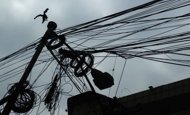Monster power cut blacks out half of India

Hundreds of miners were trapped underground in the eastern states of West Bengal and Jharkhand when the lifts failed, metro services were stopped temporarily in the capital and hundreds of trains were held up nationwide.
Federal Power Minister Sushilkumar Shinde told reporters that the monster outage, which struck around 1:00 pm (0730 GMT) in the middle of the working day, was caused by states drawing power "beyond their permissible limits".
There appeared to have been a domino effect, with the overloaded northern grid drawing too heavily on the eastern grid, which in turn led the northeastern network to collapse.
An area stretching from the western border with Pakistan to the far northeastern state of Arunachal Pradesh next to China was affected, with the huge cities of New Delhi, Kolkata and Lucknow suffering without supplies.
"Half the country is without power. It's a situation totally without precedent," said Vivek Pandit, an energy expert at the Federation of Indian Chambers of Commerce and Industry.
It took five hours to get the northeastern grid wholly back on line, while the eastern and northern networks were operating at 79 percent and 86 percent respectively by 11:30 pm.
In New Delhi, the metro train system came to a standstill for a few hours and traffic lights went out, causing chaos for a second day after a failure on the northern grid on Monday which caused the worst outage in more than a decade.
Even as Shinde struggled to explain how such enormous power failures could occur in successive days, news broke that he had been promoted to home minister in a cabinet reshuffle.
Meanwhile, on the streets, people seethed over the lack of air conditioning, crashed computer systems and missed deliveries.
"I had been waiting for a shipment of stock to arrive since morning and now I'm told it will be delayed indefinitely," said furious Delhi businessman Anshul Aggarwal.
"The stock was coming on a goods train which is now stuck in the middle of nowhere," Aggarwal said.
About 400 trains on the national rail network were hit, a railways spokesman told AFP, with all operations stopped in Uttar Pradesh, a state with a population of about 200 million people, bigger than Brazil's.
In Jaipur, capital of the western state of Rajasthan, renowned internationally as a jewellery centre, gem cutters and polishers were forced to put down their tools.
"We have almost 200,000 workers engaged in the trade and most of them operate from their houses. They don't have power back up, so it's obviously a major problem," said Vivek Kala, a former president of Jaipur Jewellers Association.
In the east, Kolkata went without power as did the surrounding state of West Bengal as the eastern grid, which supplies five states, failed under the stress of over-demand.
"This is the worst power crisis in the region. We were supplying power to the northern grid and this power sharing has led to the collapse," West Bengal state Power Minister Manish Gupta told AFP.
More than 200 coal miners were trapped deep underground in scores of pits in West Bengal for around six hours when the power cut left them unable to operate their lifts.
Mining company officials said the workers had been guided to locations where there was good ventilation and waited until the power returned and they could be brought back to the surface.
"All the miners have been rescued. They are all safe and are returning home," Eastern Coalfields Ltd. general manager Niladri Roy told AFP.
The Press Trust of India news agency reported that 65 miners had been similarly trapped in neighbouring Jharkhand state.
Monday's outage had seen the northern grid, which supplies nine states including Delhi, collapse for six hours shortly after 2:00am.
In total, 20 out of 29 states were affected on Tuesday, according to an AFP calculation.
The growing gap between electricity demand and supply in India has been highlighted by business leaders as a major obstacle to maintaining growth in Asia's third-largest economy.
The government has set a target of $400 billion of private and public investment over the next five years, but its track record is abysmal.
India has undershot every electricity goal it has set for itself in its economic plans for the past six decades -- and in the last three plans has missed capacity addition targets by 50 percent, according to the government Planning Commission.
What the stars mean:
★ Poor ★ ★ Promising ★★★ Good ★★★★ Very good ★★★★★ Exceptional
Related Contents
Latest News
More News
- 72 nations sign landmark Hanoi cybercrime convention (October 26, 2025 | 18:00)
- UN Secretary-General commends Vietnam’s global leadership (October 26, 2025 | 09:00)
- APEC finance ministers convene to tackle regional challenges (October 22, 2025 | 17:31)
- Rewiring global trade: ASEAN’s rise as supply chain hub (October 17, 2025 | 11:40)
- Vietnam attends first World Nuclear Week Forum in Russia (September 26, 2025 | 10:50)
- Vietnam attends 69th session of IAEA General Conference (September 16, 2025 | 10:00)
- ADB, WB pledge over 12 billion USD for ASEAN power grid, renewable energy projects (August 15, 2025 | 14:18)
- Lowy Institute proposes AI-based tobacco control solutions for ASEAN (August 15, 2025 | 14:14)
- Cloud computing policy to position Malaysia as regional hub by 2030 (August 15, 2025 | 14:11)
- Thailand, Cambodia suffer numerous cyber attacks (August 05, 2025 | 16:19)

 Tag:
Tag:





















 Mobile Version
Mobile Version